Bonsai, a tree in a pot
Actually, many containers can serve as a pot for a Bonsai tree, if they meet certain requirements. There has to be drainage holes of course, and wiring holes so that the tree can be fixed to the pot. They may be made out of ceramic, concrete, plastics and certain metals (metals may release toxins) and one can make their own pots. But what is considered a classic Bonsai pot is that it is made of ceramic or porcelain, and that it is stoneware burned, which means that it absorbs and holds no water in the material. It is important for the health of trees.
The tree's health comes first! A finished Bonsai often has undergone years of training to adapt their root system to smaller and smaller pots, by repotting regularly. As you already know, the practice of Bonsai is a lesson in patience and perseverance, and it certainly applies when it comes to finding the right pot. The most important thing to keep in mind when looking for a pot is the required measurement, especially the depth of the pot. In this article we'll diver into the diverse topic of Bonsai pot selection.
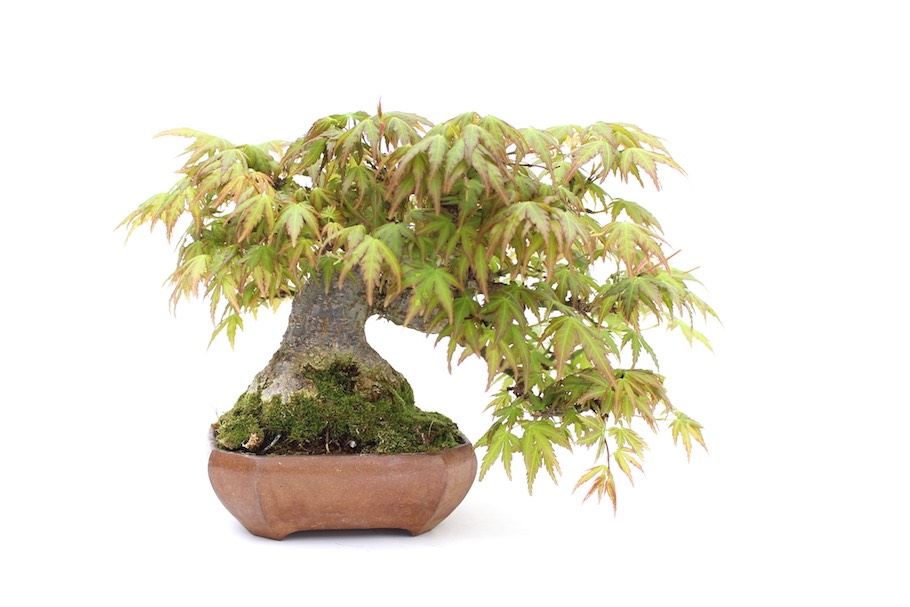
Basic guidelines on how to pick a pot
A large part of practicing Bonsai is how to be able to spot the right pot. Some go by their gut feeling. But that may be difficult for a beginner... So here are some basic rules and guidance for you to hold on to. Good luck and have fun in the pursuit of your tree´s future home.
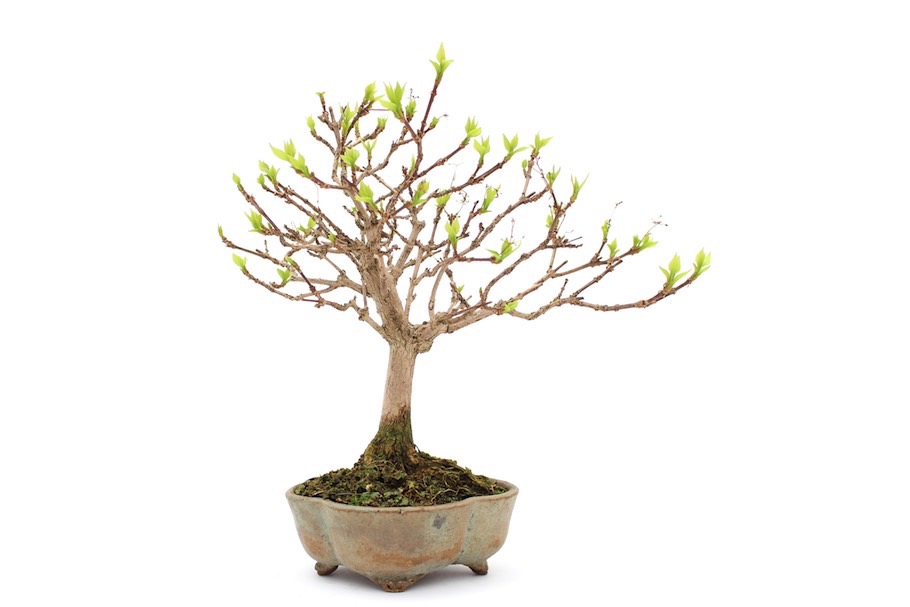
The design of a Bonsai pot
Generally masculine pots are deep, angular, have clean lines and stout feet. A lip on the rim strengthens the masculinity, an inward rhyme reinforces the pot femininity. Feminine pots often have soft lines, delicate feet and are relatively low and sleek. Round pots, drum pots are generally considered to be androgynous.
The most general rule when it comes to pot selection, and choosing the glaze for a pot, is that the color should appear in the tree. Either in the bark, the color of the leaves, and fruit or flowers. Therefore, the unglazed brown, gray and earth tones are usually safe choices. They also provide warmth and stability to the Bonsai tree. But we can also work with contrasting colors like blue or cool green. They provide balance and refreshes the composition.
The goal is to create harmony. Observe what choices others have done for their pot, discuss with others. Visit exhibitions, go to shows, read books. Do not hesitate to contact a potter. We are used to draw sketches and submit proposals for a pot that would suit your tree. Remember that there is not only one fitting choice of pot for your tree. There are usually multiple and what is best is a matter of your taste and it is you that first and foremost should be happy with your choice.
Where to buy Bonsai pots
When you think that your tree is ready, there are several ways to find a pot. You can contact a potter and make a custom order. Or, visit your local Bonsai nursery, fairs and Bonsai events where often potters are trading. Remember to bring all measurements of the tree and a photo. But if you are experienced and know what to look for, there are many auction sites and groups in social media where pots change owners. There is also the possibility that you can make your own pot? There are plenty of videos on YouTube showing you how to make a pot from different materials.
Some examples
Let's investigate a few examples of selecting the right pot for a tree. Often, rules will be broken.
Case studies: deviating from the 2/3 rule
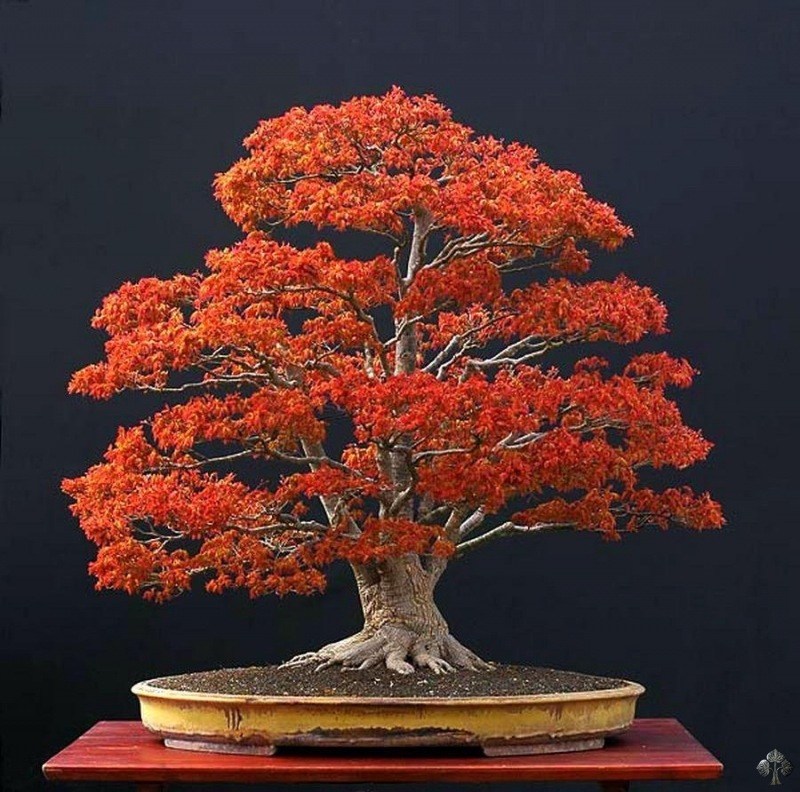
Size equals health. According to basic rules a pot should not be more than 2/3 of the height of the tree. But here the pot has deviated from this rule because of that the crown is so big, almost as wide as it is high. So it is large not only because of aesthetics and balance, but also because the branches of the tree corresponds to an equally large root system that needs space. Because of that the crown of the tree is so big, almost as wide as it is high. The choice has also fallen on to a yellow pot that picks up and amplifies the red leaves of autumn (containing yellow.)
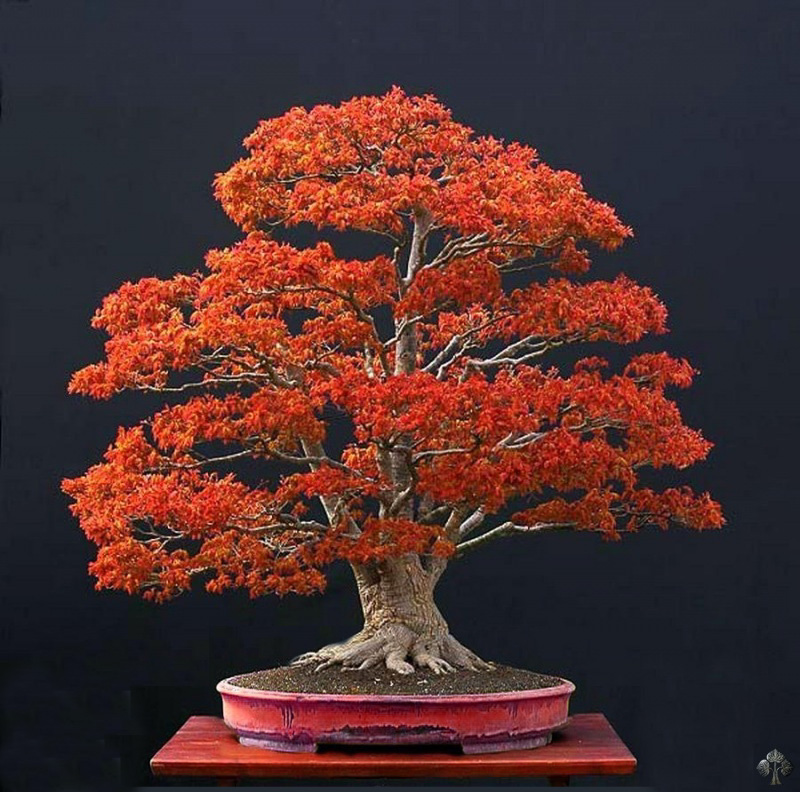
In this example you can see how it would have looked like if we followed the 2/3 rule on the width of the pot.
Case studies: Masculine vs Feminine
This is a textbook example of the perfect combination of pot and tree. The composition screams masculinity. The sparse branches, the thick scarred bark, matched perfect with a pot with clean, straight lines on stable feet. The rims lip is opening up and symbolizes, strengthens, the male outpouring force. The direct opposite of the feminine bent in, closing. The obvious choice might have been an unglazed terracotta red, instead has the choice fallen on a red glaze having the same function. It picks up the pines red-orange flesh tones.

This would probably have been my choice of pot if I got the assignment. The curved sides picks up the gently curved trunk and gives the composition a more feminine charisma.

Here we have gone all the way and removed the male lip of the pot. Note that the masculine massive feet are left. Personally, I think it is an interesting combination. You can see how the tree, unlike the first picture where the tree had a temple-like pot, now seems to be standing on top of a "hill". I get the feeling that the sac-like pot is "strangling" the shape tree. But the example clearly shows that there is more feminity in the tree then what first meets the eye.
Case studies: Forest planting
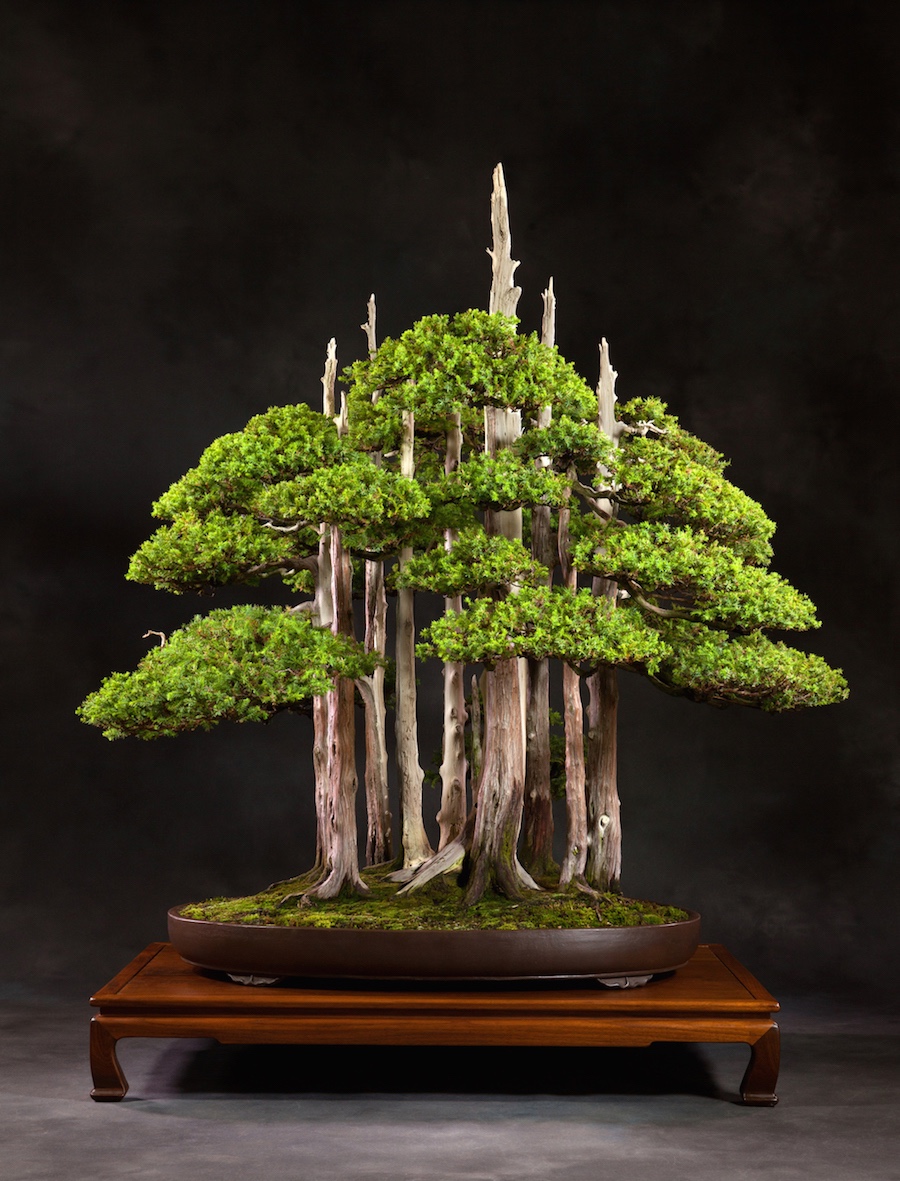
This is a legendary composition well known in Bonsai circles as "protector of the spirit". It has a long history and it represents the creator's grandchildren. The choice of pot reflects all this. Oval shape is praxis for forest planting. Here the mahogany red waxed surface is reminiscent of an antique furniture and give the tree grace and history. The pot itself is a valuable vessel that enhances age of the trees and royalty without taking any attention from them. There is no other option then an oval pot for this composition. But it would have worked with an unglazed red or glazed with earth colors. Read more about Goshin.
Case studies: Seasonal colors
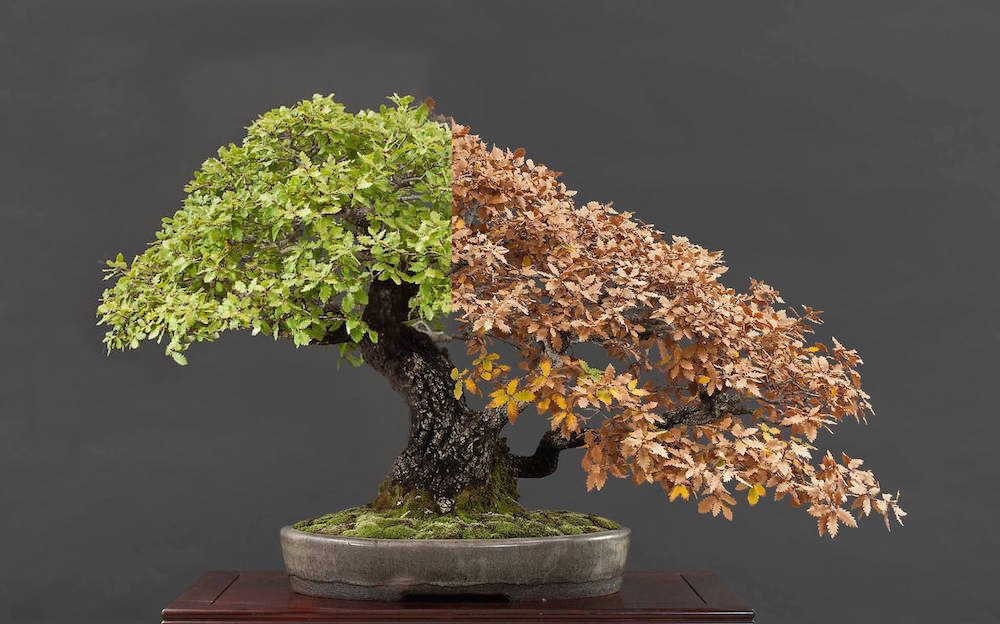
If you have a deciduous tree, whose colors change with the season, you might want to have a pot to suit all stages with their colors. Then it is easiest to choose a color that reflects the bark, such as this gray. But one can also find a tone of the leaves that will fit, or select an anonymous color like light brown or unglazed.
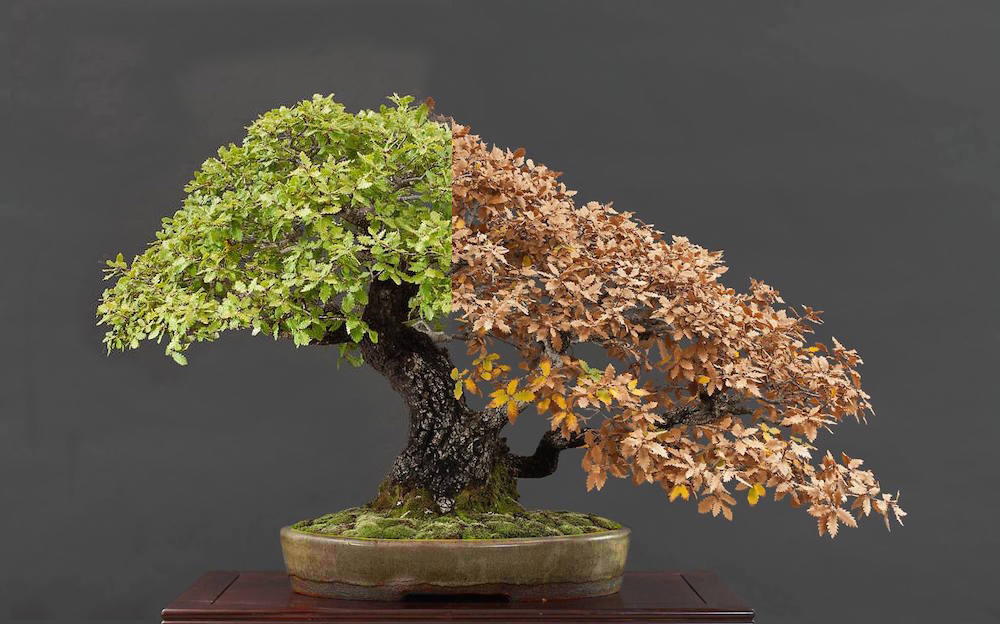
You can also choose a contrasting color such as blue or as in my example a mottled glaze with both red, green and yellow tones.
Written by Thor Holvila. Find him and many other potters here: Bonsai potters from Europe and Bonsai potters from North- and South America.






